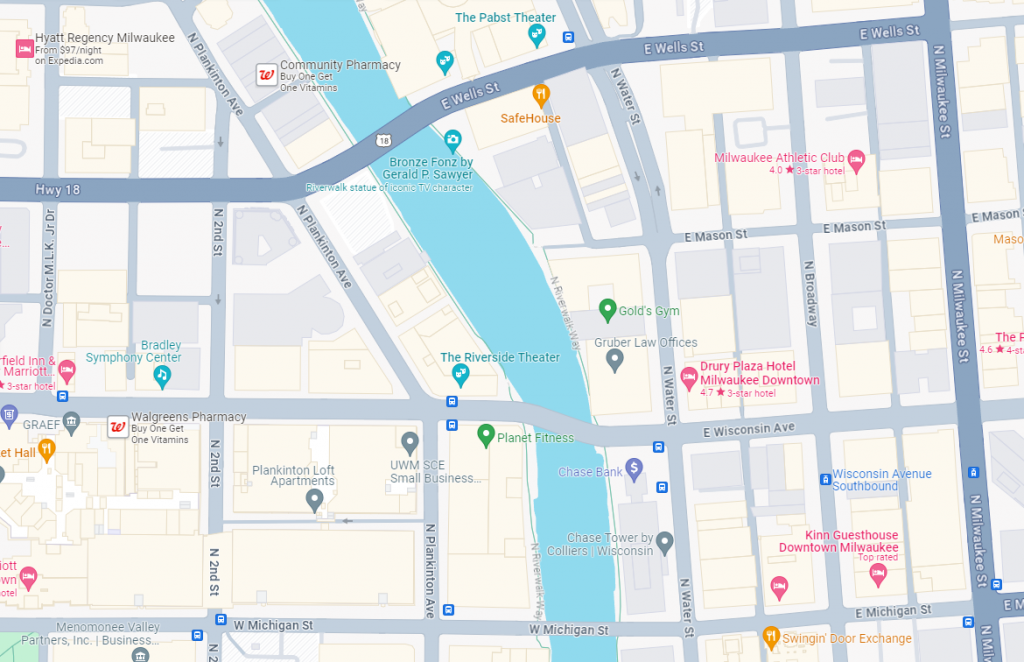When Milwaukee Went to War Over Bridges

Pictured above is a screenshot from Google Maps, showing part of Milwaukee, Wisconsin. (Here’s the actual map if you’re interested.) The body of water in the middle of the map is the Milwaukee River, and there are three roads crossing the river in the map above. The top and bottom ones are normal enough, but that middle one — Wisconsin Avenue — is a bit off. As you can see, it crosses the river slightly diagonally, which doesn’t make a lot of sense. Construction over water is more expensive than construction over land, and if you’re building a bridge, you want to do it in the shortest way possible. That slight bend isn’t very efficient.
Go back to 1845, and that was the point. And it almost led to bloodshed.
Milwaukee was officially founded on January 31, 1846, but non-Native people looking to make a better life for themselves began moving there decades earlier. In 1818, a French-Canadian fur trader and land speculator named Solomon Juneau moved to the east bank of the Milwaukee River and began a settlement he called Juneautown. Sixteen years later, two other settlers moved to the area; that year, a Connecticut-born engineer named Byrom Kilbourn started Kilbourntown on the west bank of the river, and a Virginia-born trader named George H. Walker founded Walker’s Point in the river’s southern bank. And unfortunately, the three men didn’t get along. Each one wanted their settlement to be the shining star in the area, and Kilbourn and Juneau, in particular, didn’t play nice — and transit paid the price.
As the Milwaukee County Historical Society explains, “The two settlements competed over trade and shipping in the area[.] With this competition abound, even the streets were formed so that they did not match up with the corresponding lanes on the other side, with the intention that bridges would not (or could not) be built to connect the two.” Kilbourn, who mapped out his city after Juneau’s roadways were established, typically gets the blame for this, but regardless, the street grids of their two settlements didn’t match up. Even today, if you look at a street map of Milwaukee, you can see the mismatch.
Kilbourn’s plan didn’t work, though. “In 1840,” per the Historical Society, “the Wisconsin Legislature required Milwaukee to build a drawbridge to replace an inadequate ferry system.” The first bridge was built across the river where Juneau Street is today, with Solomon Juneau’s support. Over the next few years, four more bridges were constructed — and Kilbourn and his supporters only built one, at what was then called Spring Street (and is now the Wisconsin Avenue span in the map above). Kilbourn’s crew wasn’t a fan of the others, believing that those bridges interfered with the trade routes previously accessible to Kilborntown.
And in 1845, those concerns — combined with what may have been a coincidence — turned a rivalry into a battle. Residents of Milwaukee’s western ward (that is, the Kilbourntowners) refused to pay for the upkeep of the east-built bridges, provoking the ire of those from Juneautown. On May 3, 1845, as Shepherd Express reports, “a schooner captain rammed his vessel into the bridge at Spring Street” and the rumor mill took over, with many of Kilbourn’s people believing that Juneautowners “had bribed the captain to damage the west’s preferred river span.”
In response, people on the west side began dismantling one of the bridges Solomon Juneau had agreed to construct, ultimately sending that roadway into the river below. And, as you’d expect, that didn’t go unanswered. As VisitMilwaukee.com retold, “East Siders retaliated with the destruction of the Wisconsin Avenue Bridge [then the Spring Street span] and threats to destroy the dam across the Milwaukee River. Armed brawls broke out between the inhabitants of the two towns, resulting in several serious injuries.” Per Shepherd Express, the east siders even secured a cannon and pointed it at Kilbourn’s house, only decided to forgo an attack when they heard that Kilbourn’s young daughter had recently died.
The hostilities, though, didn’t end immediately. For weeks after, people on either side of the river destroyed the bridges connecting the two towns, often showing up to do so armed with rifles and various melee weapons (like clubs, not swords). By the end of May, Milwaukee was home to only one functional bridge. Throughout the summer months, “as Shepherd Express notes, “partisans found on the wrong side of the water were sent home bloodied.” Even one bridge proved to be a bridge too far.
Thankfully for all concerned, the controversy died down as the months ticked by, and the rivalry also slowed to a crawl. The event, known as the Milwaukee Bridge War, ended without any fatalities. By December, the fledgling Milwaukee government agreed to establish a city charter and build three bridges crossing the river, and the next January, they officially founded the city of Milwaukee.
Bonus fact: If you like free hamburgers, Milwaukee is a good place to visit — if the local baseball team, the Brewers, have a good run, at least. In the 1940s, a restaurateur named George Webb owned a 24-hour diner and loved the minor league baseball team that then called Milwaukee home. He promised patrons that, if the team won 12 consecutive games, the burgers would be on the house. That minor league team is long gone and George Webb himself is no longer with us, but the chain that bears his name has kept the promise alive. If the Milwaukee Brewers win 12 in a row, George Webbs give out free burgers for a few days. It’s only happened twice — in 1987 and 2018 — but when it did, the chain was true to its founder’s word. In 1987, according to the corporate website, the restaurants gave out 168,194 burgers over three days.
From the Archives: Welcome to Temporary Anxiety: A funny little prank targeting those flying into Milwaukee.
